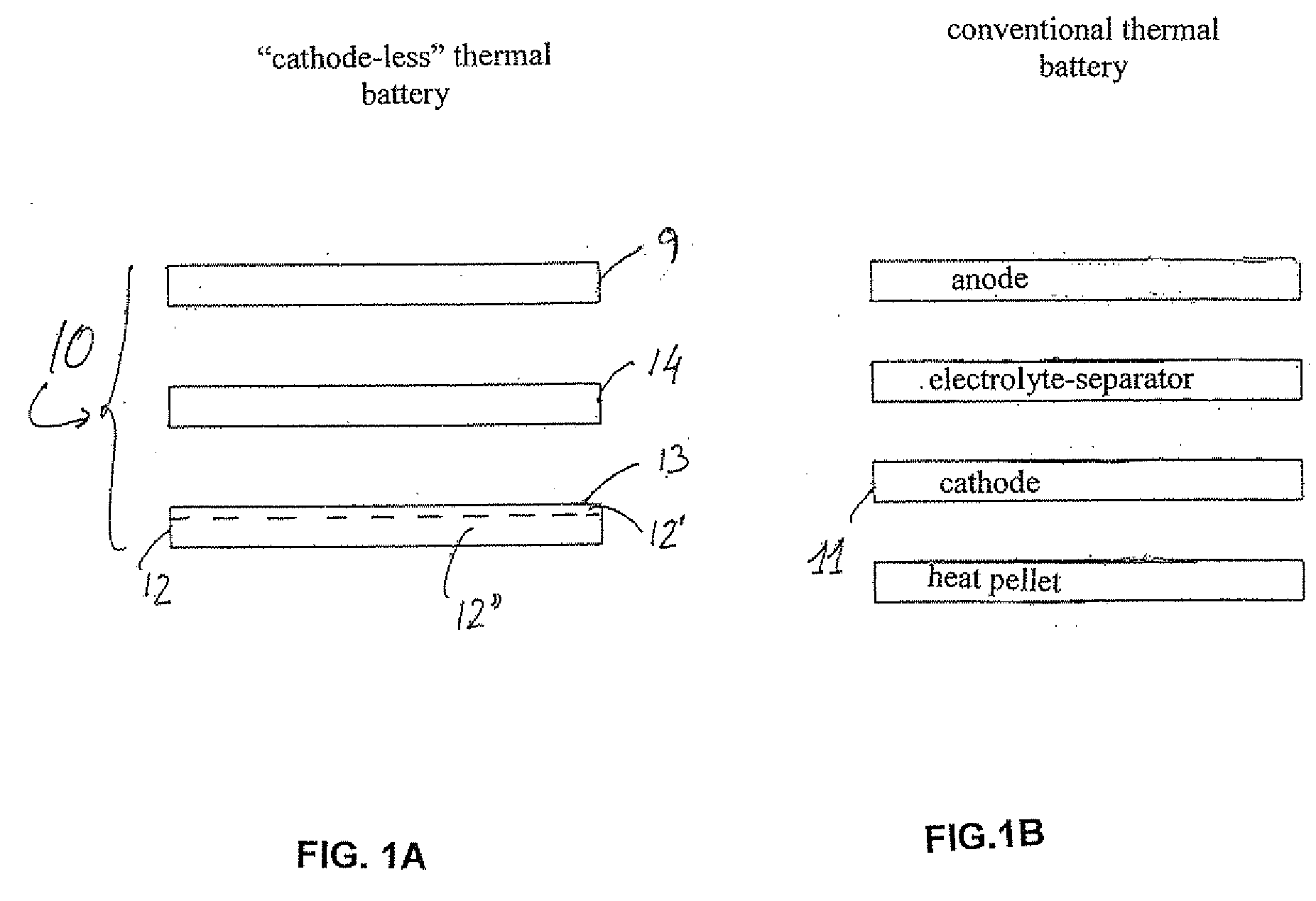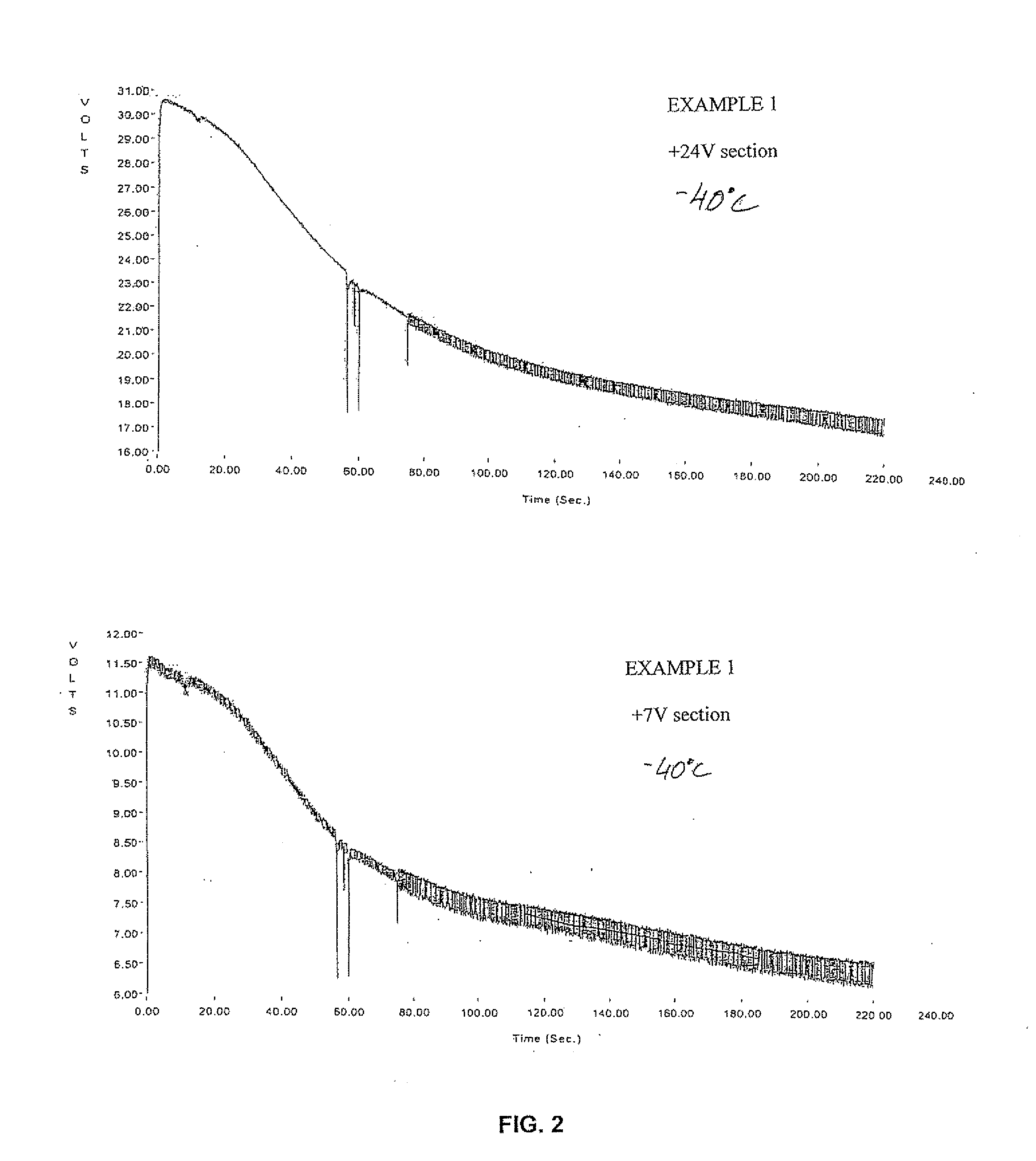Thermal batteries using cathode-precursor pyrotechnic pellets
a technology of pyrotechnic pellets and thermal batteries, which is applied in the direction of secondary cells servicing/maintenance, cell components, electrochemical generators, etc., can solve the problems of limited power delivery capability and operation life, low utilization rate of formed cathode materials by lisup>+/sup> ions during battery operation (intercalation process), etc., to achieve more reliable thermal batteries, reduce dimensions, and reduce production costs
- Summary
- Abstract
- Description
- Claims
- Application Information
AI Technical Summary
Benefits of technology
Problems solved by technology
Method used
Image
Examples
example 1
[0063] Two “cathode-less” thermal batteries were assembled. The batteries consist of two sections; a 24V section and a 7V section, made of 30 mm diameter cells. Each cell comprises 0.28 g anode, 0.67 g KCl-LiCl electrolyte-separator (having 55:45 weight percent ratio respectively) and 0.97 g cathode-precursor pyrotechnic (CPP) pellet. The CPP pellet composition was Fe-KClO4 at a weight fraction of 83% and 17% respectively. This composition provided about 314 cal / pellet at a burning rate of about 100 mm / sec without any significant gas formation.
[0064] The batteries were conditioned at −40° C. and −60° C. and then discharged at a constant load of 0.3 A with several pulses of 5 A up to 13 A. The discharge data are summarised in Table 1 and the discharge curves of the −40° C. battery are shown in FIG. 2.
[0065] In Table 1 and the forthcoming Tables; Rise-time and Life-time are defined as the two periods which passed since the activation of the battery until the section's voltage crosse...
example 2 (
the present invention)
[0066] The same batteries as in example 1 were built with the only exception of having the LiF-LiCl-LiBr eutectic electrolyte-separator instead of the KCl-LiCl electrolyte-separator. The discharge data are summarised in Table 2 and the discharge curve of the −40° C. battery is shown in FIG. 3.
TABLE 2discharge data of “cathode-less” thermal batteries of example 2.+24 V section+7 V sectiondischargeRise time,Life time,Rise time,temperaturemsecsecmsecLife time, sec−40° C.8110254185−60° C.7910253175
EXAMPLE 3 (the present invention)
[0067] One “cathode-less” thermal battery was assembled. The battery consists of two strings of 20, 30 mm diameter cells, connected in parallel to give an 28V section. Each cell comprises 0.28 g anode, 0.67 g LiF-LiCl-LiBr eutectic electrolyte-separator and 0.85 g cathode-precursor pyrotechnic (CPP) pellet. The CPP pellet composition was Fe-KClO4 at a weight fraction of 83% and 17% respectively. This composition provided about 270 cal / p...
example 4
[0069] One “cathode-less” thermal battery was assembled. The battery consists of 10, 30 mm diameter cells. Each cell mainly comprises 0.28 g anode, 0.75 g LiCl-KCl (45:55 weight ratio respectively) electrolyte-separator and 1.54 g CPP pellet. The CPP pellet composition was Fe-KClO4 at a weight fraction of 86% and 14% respectively. This composition provided about 400 cal / pellet at a burning rate of about 90 mm / sec without any significant gas formation.
[0070] The battery was discharge at room temperature at a constant load of 300 mA with pulses of 0.5 A every 40 sec. The battery life-time to 14V was 25 sec as is shown in FIG. 4 to which reference is now made.
PUM
 Login to View More
Login to View More Abstract
Description
Claims
Application Information
 Login to View More
Login to View More - R&D
- Intellectual Property
- Life Sciences
- Materials
- Tech Scout
- Unparalleled Data Quality
- Higher Quality Content
- 60% Fewer Hallucinations
Browse by: Latest US Patents, China's latest patents, Technical Efficacy Thesaurus, Application Domain, Technology Topic, Popular Technical Reports.
© 2025 PatSnap. All rights reserved.Legal|Privacy policy|Modern Slavery Act Transparency Statement|Sitemap|About US| Contact US: help@patsnap.com



